- Arabic
- French
- Russian
- Spanish
- Portuguese
- Turkish
- Armenian
- English
- Albanian
- Amharic
- Azerbaijani
- Basque
- Belarusian
- Bengali
- Bosnian
- Bulgarian
- Catalan
- Cebuano
- Corsican
- Croatian
- Czech
- Danish
- Dutch
- Afrikaans
- Esperanto
- Estonian
- Finnish
- Frisian
- Galician
- Georgian
- German
- Greek
- Gujarati
- Haitian Creole
- hausa
- hawaiian
- Hebrew
- Hindi
- Miao
- Hungarian
- Icelandic
- igbo
- Indonesian
- irish
- Italian
- Japanese
- Javanese
- Kannada
- kazakh
- Khmer
- Rwandese
- Korean
- Kurdish
- Kyrgyz
- Lao
- Latin
- Latvian
- Lithuanian
- Luxembourgish
- Macedonian
- Malgashi
- Malay
- Malayalam
- Maltese
- Maori
- Marathi
- Mongolian
- Myanmar
- Nepali
- Norwegian
- Norwegian
- Occitan
- Pashto
- Persian
- Polish
- Punjabi
- Romanian
- Samoan
- Scottish Gaelic
- Serbian
- Sesotho
- Shona
- Sindhi
- Sinhala
- Slovak
- Slovenian
- Somali
- Sundanese
- Swahili
- Swedish
- Tagalog
- Tajik
- Tamil
- Tatar
- Telugu
- Thai
- Turkmen
- Ukrainian
- Urdu
- Uighur
- Uzbek
- Vietnamese
- Welsh
- Bantu
- Yiddish
- Yoruba
- Zulu
Novemba . 28, 2024 00:50 Back to list
Understanding 2GT Timing Belts for Enhanced Performance and Durability in Mechanical Systems
Understanding 2GT Timing Belts A Comprehensive Overview
The world of mechanical engineering and automotive technology depends significantly on various components working together seamlessly. One such essential element is the timing belt, an integral part of an engine's timing system. Among the different types of timing belts available in the market, the 2GT timing belt stands out due to its unique features and applications. In this article, we will delve into the characteristics, benefits, and applications of the 2GT timing belt.
What is a 2GT Timing Belt?
The term 2GT refers to a specific profile of timing belt characterized by its design, which features a 2mm pitch and is typically made from durable materials such as neoprene or rubber. The “GT” series of belts includes various types, and the 2GT is often used in applications where precise timing and synchronization are required. These belts have teeth that engage with the accompanying sprockets, allowing for effective transfer of power while maintaining an accurate timing sequence, which is critical for engine operation.
Characteristics of 2GT Timing Belts
1. High Precision and Efficiency The 2mm pitch allows for precise synchronization between the crankshaft and camshaft, ensuring that the engine's valves open and close at the correct times. This precision contributes to overall engine efficiency and performance.
2. Durability 2GT timing belts are constructed from robust materials that resist abrasion, temperature fluctuations, and oil exposure. This durability ensures that the belts have a longer lifespan, reducing the need for frequent replacements and maintenance.
3. Flexibility These belts are designed to be flexible, allowing them to handle various bend radii without risking damage. This makes them suitable for different engine designs and configurations.
4. Reduction in Noise Compared to traditional chain systems, timing belts typically operate more quietly, contributing to a smoother driving experience.
Benefits of Using a 2GT Timing Belt
2gt timing belt

1. Cost-Effectiveness In comparison to other timing systems, such as chains or gears, 2GT timing belts are often more affordable to produce and maintain. This makes them a popular choice for both manufacturers and car owners looking to reduce costs.
2. Simplicity of Installation The installation of a timing belt is generally simpler and requires less specialized tooling than other systems, simplifying the repair and replacement process.
3. Reduced Weight 2GT timing belts are lighter than their chain counterparts, which can contribute to overall weight reduction in vehicles and improved fuel efficiency.
4. Less Maintenance With no need for oiling and fewer moving parts than a chain system, timing belts require less maintenance, making them user-friendly and reliable for day-to-day operations.
Applications of 2GT Timing Belts
The versatility of 2GT timing belts allows them to be used across various industries and applications, including
- Automotive Widely used in automotive engines for timing mechanisms. - Robotics Employed in robotic arms and mechanisms where precise motion control is necessary. - 3D Printers Featured in many 3D printer designs, where accurate movement of the nozzle and build platform is crucial. - Industrial Machinery Utilized in conveyor belts and other machinery requiring synchronized movement.
Conclusion
In summary, the 2GT timing belt is a vital component in various mechanical systems, offering several advantages such as efficiency, durability, and cost-effectiveness. Its ability to provide precise synchronization makes it an ideal choice for automotive engines and other applications where timing is critical. As technology continues to evolve, the importance of reliable and efficient components like the 2GT timing belt will only grow, ensuring that it remains a staple in engineering and manufacturing processes. Whether you are an automotive enthusiast, a professional mechanic, or an engineer, understanding the functionality and benefits of the 2GT timing belt can enhance your appreciation of the intricate systems that power our vehicles and machinery.
-
Korean Auto Parts Timing Belt 24312-37500 For Hyundai/Kia
NewsMar.07,2025
-
7PK2300 90916-T2024 RIBBED BELT POLY V BELT PK BELT
NewsMar.07,2025
-
Chinese Auto Belt Factory 310-2M-22 For BMW/Mercedes-Benz
NewsMar.07,2025
-
Chinese Auto Belt Factory 310-2M-22 For BMW/Mercedes-Benz
NewsMar.07,2025
-
90916-02660 PK Belt 6PK1680 For Toyota
NewsMar.07,2025
-
drive belt serpentine belt
NewsMar.07,2025

